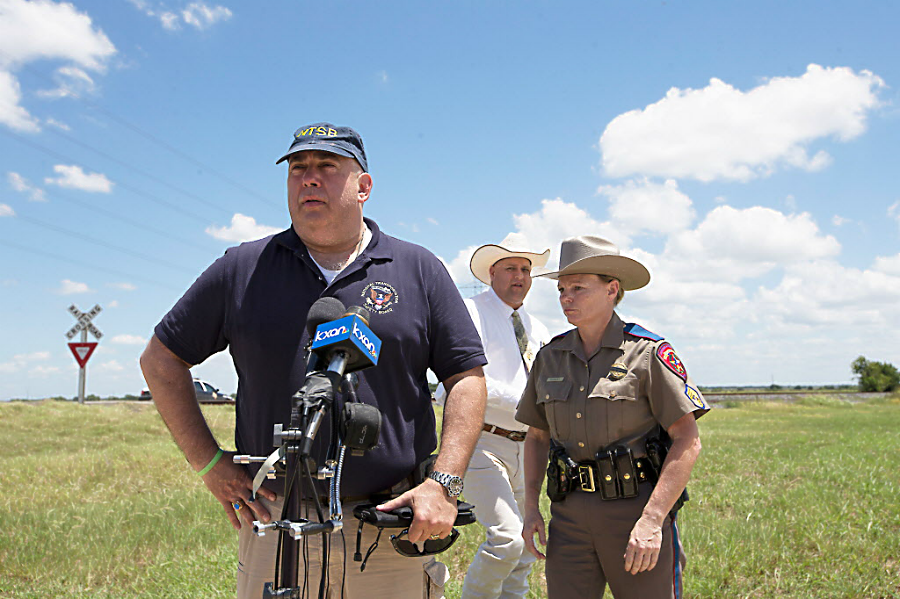Could the deadly hot air balloon crash in Texas have been avoided?
Loading...
The deadliest hot air balloon crash in US history has resurfaced calls by the National Transportation Safety Board (NTSB) for the Federal Aviation Administration (FAA) to further regulate hot air ballooning.
The FAA’s rejection of these recommendations, issued because the agency deemed the risks were too low, has raised questions over whether the crash in Texas Saturday that killed all 16 passengers aboard the balloon could have been prevented if the FAA heeded the board’s warnings.
Two years ago, then-NTSB chairwoman Deborah Hersman wrote in a letter addressed to FAA Administrator Michael Huerta that just one balloon crash could lead to a “high number of fatalities.”
“The potential for a high number of fatalities in a single air tour balloon accident is of particular concern if air tour balloon operators continue to conduct operations under less stringent regulations and oversight,” wrote Ms. Hersman.
She referenced a February 2013 crash in Luxor, Egypt. The deadliest balloon crash on record killed 19 of the 21 passengers, when a gas canister exploded in the gondola of the balloon, hurtling it 1,000 feet to the ground.
Although "such an accident has yet to occur" in the US, Hersman wrote, "based on the number of recurring accidents in the United States involving similar safety issues, the NTSB believes that air tour balloon operators should be subject to greater regulatory oversight."
The fears raised two years ago came true Saturday when a commercial balloon crashed in a pasture near Lockhart, Texas, about 30 miles south of Austin. According to early reports, the balloon first caught fire in the air. It’s unclear if the fire was the result of a gas explosion or a collision with high-capacity electrical transmission wires.
Margaret Wylie, who lives near crash site, told the Associated Press she heard a "pop, pop, pop."
"I looked around and it was like a fireball going up," she said, noting the fireball was under large power lines and almost high enough to reach the bottom of them.
In Hersman’s 2014 letter to Mr. Huerta, the NTSB recommended the FAA should subject tour balloon operators to the same regulations as their commercial airplane and helicopter counterparts.
Currently, balloon operators must be licensed. In order to receive this certification, they must complete a course, pass an examination, and demonstrate proficiency during a test flight with an inspector, FAA officials told the Houston Chronicle. Operators must also keep maintenance records for the balloon, heating units, and other equipment.
Reviews by the NTSB of three other crashes in 2013, 2008, and 2007, wrote Hersman, showed a lack of surveillance checks and other oversight contributed to “operational deficiencies” in commercial balloon flights. These included failing to follow the flight manual and ignoring weather conditions.
In November 2015, Huerta responded to the NTSB recommendations, saying they were unnecessary because the risks were too low.
“Since the amount of ballooning is so low, the FAA believes the risk posed to all pilots and participants is also low given that ballooners understand the risks and general hazards associated with this activity,” wrote Huerta. “Although surveillance for ballooning activity is not carried out in the traditional sense… the FAA regularly attends sanctioned ballooning events and performs certain oversight activities, such as checking pilot credentials and reviewing the airworthiness condition of the balloon.”
The NTSB then responded in March, encouraging the FAA to reconsider its position.
“We are concerned that, if no action is taken to address this safety issue, we will continue to see such accidents in the future,” wrote NTSB. “Since these recommendations were issued in April 2014, an additional 25 balloon accidents have occurred, resulting in 4 fatalities and 25 serious injuries.”
From 1964 to May 2014, the NTSB had investigated 775 balloon incidents in the US, 70 involving fatalities. Since then, the NTSB database shows two more fatalities.
The Balloon Federation of America, a trade group, declined, in a statement, to comment about the crash Saturday because an investigation is ongoing. But it previously said the NTSB recommendations to the FAA "will not improve safety, will prove burdensome to both the industry and the FAA, and is unnecessary given the BFA’s recent initiatives in this arena and its ongoing safety education programs." Instead, it supported a partnership "to develop and implement qualitative programs that will achieve enhanced safety for balloon pilots, crew, and the flying public without adding unnecessary and burdensome regulation."
FAA spokesman Lynn Lunsford told the Chronicle Saturday it’s too early to know if the NTSB recommendations would have prevented the fatal crash.
“It’s all going to depend on what the evidence shows,” said Lunsford. “It may be what came into play in this accident wouldn’t have been charged by the NTSB recommendation, and that does not make their recommendation any less valid.”







